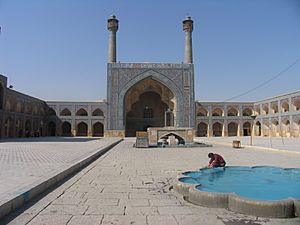Iwan facts for kids
An Iwan, also spelled ivan, is a rectangular hall or space, usually vaulted, walled on three sides, with one end entirely open. The formal gateway to the iwan is called pishtaq, a Persian term for a portal projecting from the face of a building, usually decorated with calligraphy bands, glazed tilework, and geometric designs.
Since the definition allows for some interpretation, the overall forms and characteristics can vary greatly in terms of scale, material, or decoration. Iwans are most commonly associated with Islamic architecture; however, the form is Iranian in origin and was invented much earlier and fully developed in Mesopotamia around the third century CE, during the Parthian period of Persia.
Typically, iwans open on to a central courtyard, and have been used in both public and residential architecture.
Images for kids
-
Multiple iwans and tiled domes of the 16th-century Persian-style Mir-i-Arab madrasa, Bukhara, Uzbekistan
-
The courtyard of the Great Mosque of Isfahan, one of the earliest and most prominent uses of the four-iwan plan in mosque architecture, introduced in the early 12th century
-
The iwan of the Palace of Ardashir
-
Iwan inside the Hospital of Divriği, Turkey, built in Anatolia under Seljuk domination in the 13th century
-
Iwan in the Al-Firdaws Madrasa in Aleppo, Syria, built by the Ayyubids in the 13th century
-
Iwan entrance of the Bibi-Khanym Mosque in Samarkand, Uzbekistan, built by Timur in the early 15th century
-
Iwan of the Āmeri House in Kashan, Iran (18th century)
-
Çifte Minareli Medrese (13th century) in Erzurum, Turkey, a variation of the four-iwan plan in Anatolian Seljuk architecture
-
Four-iwan layout at the Mosque-Madrasa of Sultan Hasan (14th century) in Cairo, Egypt
See also
 In Spanish: Iwán para niños
In Spanish: Iwán para niños



















